|
May 1961 Popular Science
 [Table of Contents] [Table of Contents]
Wax nostalgic about and learn from the history of early
electronics. See articles from
Popular
Science, published 1872-2021. All copyrights hereby acknowledged.
|
At least two relatively new
methods of wireless communications was employed in the "Earth Radio" system for
intercontinental ballistic missile (ICBM) launch control in this 1961 issue of
Popular Science magazine. Surface wave transmission would provide the
signal medium from ICBM command and control centers to the underground silos
where the missiles were stored, ready to launch at a moment's notice if Russia
decided to initiate a nuclear attack on the homeland. Author Pursglove pays
tribute to amateur radio's contribution to pioneering the science of surface
waves. The other pioneering technology being used was spread spectrum
encoding/decoding. Both methods provide innate security advantages. Surface
waves are a relatively short range transmission means, so anyone wanting to
transmit or receive bogus signals needs to be nearby. Spread spectrum, whether
frequency hopping (FHSS) or direct sequence (DSSS) requires a key for decoding
or encoding signals, so spoofing is nearly impossible. Another form of
communications for through-the-earth signaling, called Lithocom (lithosphere
communications), was also explored. It was eventually found useful in mining
operations.
How "Earth Radio" Would Launch ICBMs
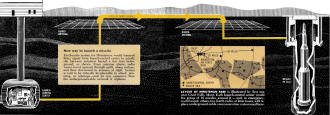
New way to launch a missile
Earth-radio
system for Minuteman would transmit firing signal from launch-control center to
missile silo between antennas buried a few feet below ground, as shown. From antenna
above, radio waves travel upward through earth, along surface, and then downward
to antenna at right. System is said to be virtually invulnerable to attack, jamming,
or sabotage-and far less expensive than the underground-cable network it replaces.
Layout of Minuteman Base is illustrated by first
one near Great Falls, Mont. Each launch-control center would fire group of 10 missiles
around it - and, in emergency, could launch others, too. Earth radio, at later bases,
will replace underground-cable communication system used here.
A novel method of subterranean signaling has evolved from a makeshift
expedient of World War I. Now it's a practical and invulnerable launch-control system
for our newest missiles. A deep-down version of earth radio, for civilian uses,
gets a successful tryout at 1,000-foot depth.
By S. David Pursglove
If the command to fire must ever be flashed to Minuteman missiles at our newest
bases, it will be transmitted by signals pulsing through the earth. The solid-fueled
ICBMs' launch-control system will employ a method of communication unheard of, until
now, by the general public-underground radio.
This will be its first practical installation. Its principle, long known to scientists,
was crudely applied in World War I and has been experimented with by radio amateurs.
But it is only within the last three years that new researches have perfected the
radical technique.
As applied for military use, "earth radio" works this way: Signals from an underground
transmitter are emitted by a grid like antenna buried a few feet beneath the ground.
They travel upward to the surface, and proceed along it - both in the uppermost
few feet of earth and in the air just above. Then, descending again, the signals
are picked up by a second buried antenna like the first.
Scene of an installation will be a missile base of the latest "hardened" type,
designed to withstand a surprise hydrogen attack and still launch its missiles.
Out of sight below ground, the ready-to-go Minuteman ICBMs are poised in crewless,
bombproof concrete silos, scattered widely about the countryside. The firing command
would come by way of manned launch-control centers, "LCCs" for short, likewise underground.
If any LCC had been knocked out by a bull's-eye hit, another one would be able to
take over and launch its missiles.
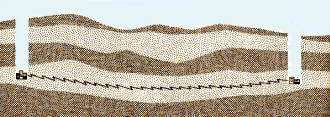
Signal Travels through deep layer of rock, in
Lithocom earth-radio system. Adjacent layers form boundaries of a natural waveguide,
extending range of radio waves.
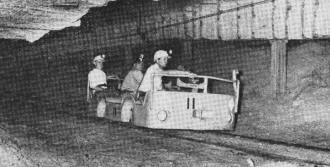
On Way to Work, the radio experimenters ride
through tunnel of potash mine near Carlsbad, N. M. Starting a 7-a.m-to-11-p.m. day,
they quipped, "Back to the salt mine."
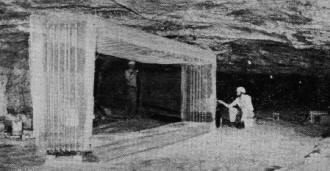
Test Center for deep transmitting trials occupies
end of abandoned gallery in potash mine. Long earth-radio antenna, at left, runs
along its roof and floor. Teletype is in background.
Chicken wire and heating pipes make up this
underground-radio antenna - one of a number of experimental ones.
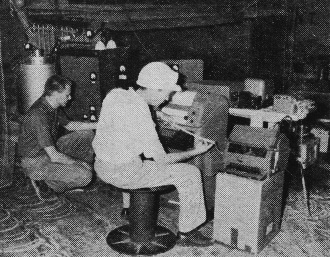
Success rewards experimenters as radio-teletype
message travels record 4 1/2 mile distance through earth, at 1,000·foot depth, from
machine in photo to similar one in another mine.
Linking LCCs and missile silos, therefore, calls for an elaborate remote-control
communication network, equally proof against full-scale attack or sabotage. Our
first 150-silo Minuteman base near Great Falls, Mont., which was planned before
the unconventional radio technique was perfected, will use an intricate system of
underground signal cables. Earth radio will take the place of most of the cable
network at other Minuteman bases soon to come.
It's Cheaper
Big advantage of the novel radio system is that it eliminates cable costing $20,000
to $25,000 a mile. That means a saving of about $300,000 per missile, the Air Force
estimates.
"We are convinced that the system is practical," says Lt. Gen. B. A. Schriever,
commander of the Air Research and Development Command. "It will be a virtually jamproof
communication network, and highly invulnerable to sabotage."
While details are largely secret, this much more is revealed about the system:
It will provide "a continuous report on the status of each missile" and of its silo.
And it will use "spread-spectrum" transmission, meaning that its radio waves will
have a wide range of frequencies. This guards against deliberate interference; a
prohibitive amount of power would be required to jam the whole range.
The story behind earth radio goes back to World War I, when the German advance
on Paris cut off a French army unit from its main force. The unit's signalmen, the
tale goes, thrust two bayonets into the ground a few feet apart. They attached a
buzzer, to serve as an oscillator, and had a crude wireless-telegraph transmitter.
Meanwhile the main body of French troops - following instructions from a runner
who had gotten through - set up a similar receiver, using headphones instead of
a buzzer. The "earth wireless" worked - and the code messages led to the rescue
of the trapped men.
The Hams Tried It, Too
In later years, amateur radio experimenters have tinkered with the scheme. Instead
of connecting his sending-receiving outfit to antenna and ground, a ham would make
one connection to a grounded water pipe - and the other to a metal rod sunk in the
earth some distance away. Then he could exchange signals with another amateur, living
nearby, who had done the same.
The trouble was, such experiments showed, that earth radio had a much shorter
range than conventional radio - and took more power to span equal distance. So it
remained just a scientific curiosity, until the coming of the missile age finally
brought a use for it.
Development of Minuteman's shallow or surface-hugging system of earth radio began
in mid-1958. Under an ARDC contract, experimenters of Space Electronics Corp., Glendale,
Calif., conducted sub-surface trials under water and in a mine. Eventually they
reported obtaining a strong signal more than 1,000 miles from a transmitter of 250-kilowatt
power output.
Special antennas for the system were tested by the Boeing Airplane Company in
earth-radio trials of its own, and transmitting and receiving equipment was developed
by Sylvania Electric Products. The National Bureau of Standards also lent a helping
hand.
Early last December, the Air Research and Development Command - considering the
adoption of the earth-radio launch-control system for Minuteman - began a full-scale
trial to confirm its practicality and reliability. In February of this year, the
ARDC announced that it intended to use the system.
Radio Through Rocks
Meanwhile another kind of earth radio, called Lithocom, has been independently
developed by an Eastern firm. In contrast with the Air Force's "shallow" system,
this is a "deep" one - its waves travel through subterranean rock without ever approaching
the surface. Civilian applications, principally, are foreseen for it. tried
out by Deco engineers to transmit signals through earth.
Lithocom was born in mid-1959, when recent geophysical studies suggested that
deep-down radio was feasible. Although radio waves peter out comparatively quickly
in deep rock, engineers of the Developmental Engineering Corp., Washington, D. C.,
theorized that their range could be greatly extended by taking advantage of favorable
rock formations.
In the earth's upper crust, for example, a dry layer of sedimentary rock bounded
by moist conducting ones should form a natural "waveguide" or conduit for subterranean
radio waves. And so should a readily available "laboratory model" - a natural underground
bed of salt, with an overburden of more-conductive rock.
Ready for actual trials by February, 1960, Deco engineers invaded two mines near
Carlsbad, N. M., that had offered to cooperate. They set up their transmitter in
an abandoned portion of the Potash Company of America workings, where the ore had
become too thin to mine - an ideal place to work undisturbed. Their receiver went
into a tunnel of the U. S. Borax and Chemical Company mine.
At the start of their day the electronic engineers could truthfully say, "Well,
back to the salt mine." They reported at seven a.m. with the first mining shift,
rode three miles underground by narrow-gauge railway - and still had a half-mile
walk, through a passage only 4 1/2 feet high, to their transmitting test site. The
reddish salt of the mine walls made cuts, scratches, and closely shaven faces sting.
Taking so long to reach their location and return, the engineers had to stay during
two mining shifts; usually they got back to the surface with the swing shift at
11 p.m.
Coming: Voice Transmission
On July 28, 1960, after numerous attempts, the first signal was successfully
transmitted. It traveled a record 4 1/2 miles, at 1,000-foot depth. The feat was
performed with a radio-teletype circuit, and a low-power transmitter operating at
less than 200 watts' output. With more power, Deco engineers say, voice transmission
and 100-mile range would be feasible.
For the Lithocom system of earth radio, the Deco engineers see many possible
applications.
Installed in a large mine, a communication system of this kind could aid everyday
operations - and, in an emergency, speed mine-rescue work.
The shielding effect of overlying earth makes the Lithocom system virtually noiseless.
Therefore it has interesting possibilities for supplementing more-conventional channels
of communication wherever static from electrical storms or man-made electrical noise
interferes with their use.
Finally, the engineers note, the alternating wet and dry layers of the earth's
crust offer multiple paths for Lithocom channels. Even on the same frequency, messages
could be transmitted through different rock belts without interference between them.
Will the answer to the problem of overcrowded air waves be to detour radio traffic
through the earth?
So new is earth radio in its first practical forms that it is still too early
to foresee how far this development may go.
Posted May 1, 2024
|














